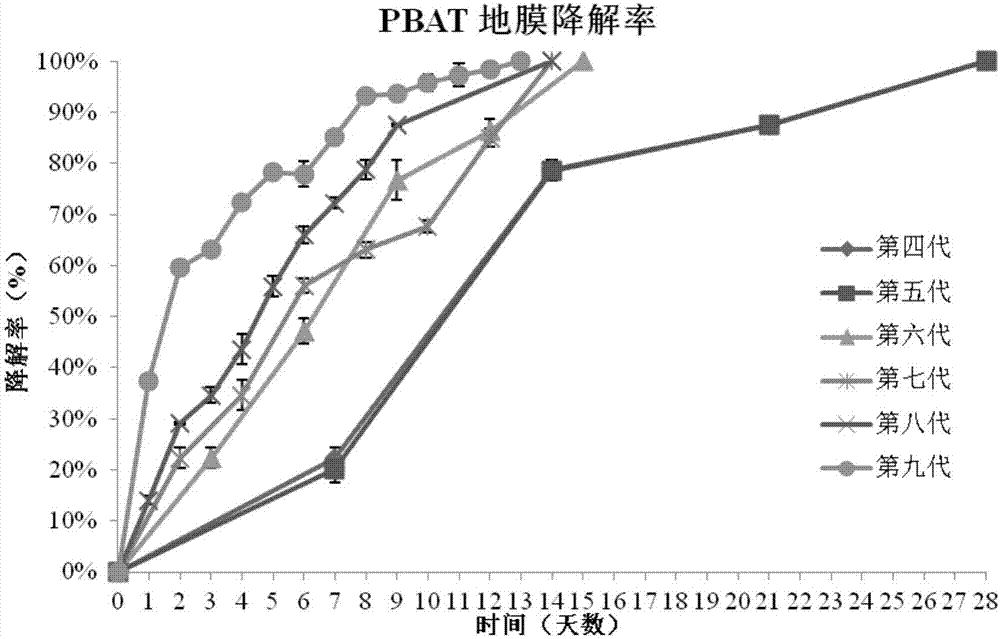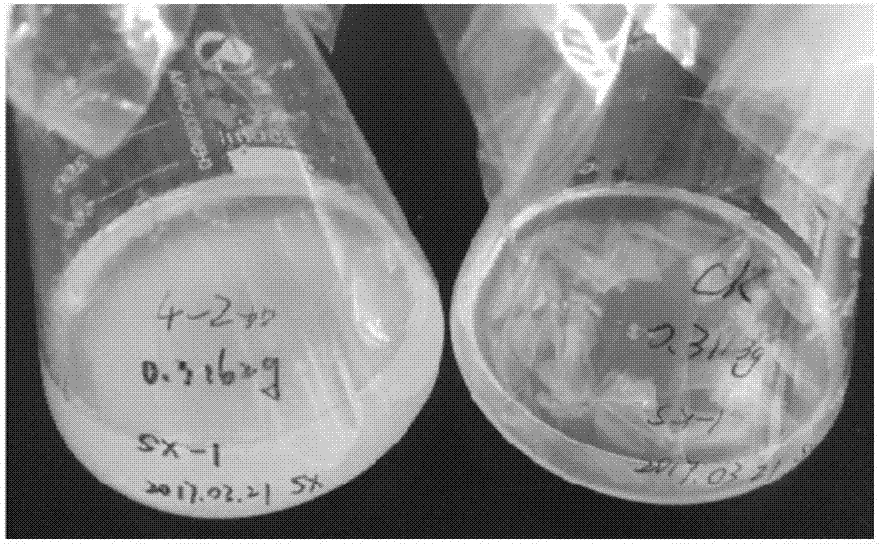Microbial flora capable of efficiently degrading PBAT plastic mulching film
A technology of plastic mulch and bacterial colony, applied in the direction of microorganisms, methods based on microorganisms, methods using microorganisms, etc., can solve the problems of incomplete degradation and slow degradation rate, and restrict the development of PBAT plastic mulch
- Summary
- Abstract
- Description
- Claims
- Application Information
AI Technical Summary
Problems solved by technology
Method used
Image
Examples
Embodiment 1
[0016] Example 1: Screening of efficient PBAT plastic mulch degrading flora
[0017] Source of soil samples: The soil environment samples used in this experiment were from the greenhouse of Shandong Shouguang Vegetable Base, Fujian Anxi Tea Garden, Xinjiang 81, 84 Construction Corps, Guangzhou Compost Factory, Indonesian Palm Garden and Tianjin Institute of Industrial Biotechnology, Chinese Academy of Sciences. Soil samples. The soil sampling depth is 5-10cm, and the collected soil samples are stored in completely sterilized transparent sealed bags and sealed bottles, numbered, sealed, and stored in a 4°C refrigerator for later use.
[0018] Preliminary screening process: The soil samples are the above-mentioned soil samples collected from all over the country, and they are enriched and cultivated in the above-mentioned newly invented SX medium with PBAT plastic mulch as the only carbon source and energy source. The specific operation is as follows: Add 10.0g of soil samples ...
Embodiment 2
[0020] Embodiment 2: Domestication of efficient PBAT plastic mulch degrading flora
[0021] Subculture and acclimatization of degrading bacteria: After initial discovery (adding 10.0g soil sample) that the PBAT plastic mulch can be degraded into a paste, the degradable bacterial solution of the soil treatment group was used as the first generation, and 10mL of the bacterial solution was taken again according to the 10% of the inoculation was transferred to the SX medium containing 300mgPBAT mulch film with a size of about 3cm×3cm for the second, third, fourth... N generations, and the transfer was performed once in 28 days.
[0022] In the SX medium with PBAT plastic mulch as the only carbon source, a microbial flora SX that can degrade PBAT plastic mulch was screened from the soil samples of Xinjiang 84 regiment on December 22, 2016, and PBAT plastic mulch was found A clear disintegration phenomenon can be found in it. After culturing at 37 degrees Celsius for 28 days, it wa...
Embodiment 3
[0024] Example 3: Analysis of the community structure of highly efficient PBAT plastic mulch degrading bacteria
[0025] The degrading bacteria group SX screened from soil samples in the cotton field of Xinjiang 84th Construction Corps after continuous domestication. Utilize SX culture medium of the present invention, its composition and proportioning (g / L) are as follows: NH 4 NO 3 1.0~2.0, MgSO 4 ·7H 2 O 0.2~1.0, K 2 HPO 4 1.0~2.0, CaCl 2 2H 2 O 0.1~1.0, KCl 0.15~0.5 and 1.0~10.0mg / L FeSO 4 ·6H 2 O,ZnSO 4 ·7H 2 O and MnSO 4, the pH is 7.6-8.0; the amount of PBAT plastic film added is 300 mg per 100 ml of the above medium, and the PBAT plastic film is used as the only carbon source. The flora mainly uses PBAT plastic mulch as the only carbon source required for growth. After continuous domestication, a group of complex microbial flora for the degradation of PBAT plastic mulch has been obtained, which has excellent removal properties when degrading PBAT plastic m...
PUM
 Login to View More
Login to View More Abstract
Description
Claims
Application Information
 Login to View More
Login to View More - R&D
- Intellectual Property
- Life Sciences
- Materials
- Tech Scout
- Unparalleled Data Quality
- Higher Quality Content
- 60% Fewer Hallucinations
Browse by: Latest US Patents, China's latest patents, Technical Efficacy Thesaurus, Application Domain, Technology Topic, Popular Technical Reports.
© 2025 PatSnap. All rights reserved.Legal|Privacy policy|Modern Slavery Act Transparency Statement|Sitemap|About US| Contact US: help@patsnap.com



